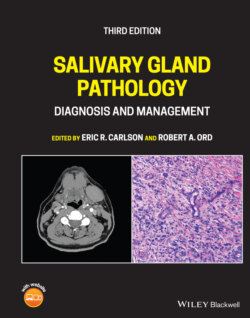Читать книгу Salivary Gland Pathology - Группа авторов - Страница 29
Nerve Supply to the Parotid
ОглавлениеThe parasympathetic secretomotor nerve supply comes from the inferior salivatory nucleus in the brain stem (Figure 1.9). From there, the fibers run in the tympanic branch of the glossopharyngeal nerve contributing to the tympanic plexus in the middle ear. The lesser petrosal nerve arises from the tympanic plexus leaving the middle ear and running in a groove on the petrous temporal bone in the middle cranial fossa. From here, it exits through the foramen ovale to the otic ganglion which lies on the medial aspect of the mandibular branch of the trigeminal nerve. Postsynaptic postganglionic fibers leave the ganglion to join the auriculotemporal nerve which distributes the parasympathetic secretomotor fibers throughout the parotid gland. Some authorities suggest that there are also some parasympathetic innervations to the parotid from the chorda tympani branch of the facial nerve.
The sympathetic nerve supply to the parotid arises from the superior cervical sympathetic ganglion. The sympathetic fibers reach the gland via the plexus around the middle meningeal artery. They then pass through the otic ganglion without synapsing and innervate the gland through the auriculotemporal nerve. There is also sympathetic innervation to the gland arising from the plexuses that accompany the blood vessels supplying the gland.
Figure 1.9. The parasympathetic innervations of the salivary glands. The parasympathetic fibers are shown as blue lines.
Sensory fibers arising from the connective tissue within the parotid gland merge into the auriculotemporal nerve and pass proximally through the otic ganglion without synapsing. From there, the fibers join the mandibular division of the trigeminal nerve. The sensory innervation of the parotid capsule is via the great auricular nerve.
